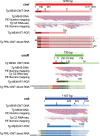A novel fragmented mitochondrial genome in the protist pathogen Toxoplasma gondii and related tissue coccidia
- PMID: 33906963
- PMCID: PMC8092004
- DOI: 10.1101/gr.266403.120
A novel fragmented mitochondrial genome in the protist pathogen Toxoplasma gondii and related tissue coccidia
Abstract
Mitochondrial genome content and structure vary widely across the eukaryotic tree of life, with protists displaying extreme examples. Apicomplexan and dinoflagellate protists have evolved highly reduced mitochondrial genome sequences, mtDNA, consisting of only three cytochrome genes and fragmented rRNA genes. Here, we report the independent evolution of fragmented cytochrome genes in Toxoplasma and related tissue coccidia and evolution of a novel genome architecture consisting minimally of 21 sequence blocks (SBs) totaling 5.9 kb that exist as nonrandom concatemers. Single-molecule Nanopore reads consisting entirely of SBs ranging from 0.1 to 23.6 kb reveal both whole and fragmented cytochrome genes. Full-length cytochrome transcripts including a divergent coxIII are detected. The topology of the mitochondrial genome remains an enigma. Analysis of a cob point mutation reveals that homoplasmy of SBs is maintained. Tissue coccidia are important pathogens of man and animals, and the mitochondrion represents an important therapeutic target. The mtDNA sequence has been elucidated, but a definitive genome architecture remains elusive.
© 2021 Namasivayam et al.; Published by Cold Spring Harbor Laboratory Press.
Figures







Similar articles
-
Massive invasion of organellar DNA drives nuclear genome evolution in Toxoplasma.Proc Natl Acad Sci U S A. 2023 Nov 7;120(45):e2308569120. doi: 10.1073/pnas.2308569120. Epub 2023 Nov 2. Proc Natl Acad Sci U S A. 2023. PMID: 37917792 Free PMC article.
-
Characterisation of full-length mitochondrial copies and partial nuclear copies (numts) of the cytochrome b and cytochrome c oxidase subunit I genes of Toxoplasma gondii, Neospora caninum, Hammondia heydorni and Hammondia triffittae (Apicomplexa: Sarcocystidae).Parasitol Res. 2013 Apr;112(4):1493-511. doi: 10.1007/s00436-013-3296-4. Epub 2013 Jan 29. Parasitol Res. 2013. PMID: 23358734
-
Broad genomic and transcriptional analysis reveals a highly derived genome in dinoflagellate mitochondria.BMC Biol. 2007 Sep 27;5:41. doi: 10.1186/1741-7007-5-41. BMC Biol. 2007. PMID: 17897476 Free PMC article.
-
Genome structure and gene content in protist mitochondrial DNAs.Nucleic Acids Res. 1998 Feb 15;26(4):865-78. doi: 10.1093/nar/26.4.865. Nucleic Acids Res. 1998. PMID: 9461442 Free PMC article. Review.
-
Evolution of the mitochondrial genome: protist connections to animals, fungi and plants.Curr Opin Microbiol. 2004 Oct;7(5):528-34. doi: 10.1016/j.mib.2004.08.008. Curr Opin Microbiol. 2004. PMID: 15451509 Review.
Cited by
-
Third-generation sequencing revises the molecular karyotype for Toxoplasma gondii and identifies emerging copy number variants in sexual recombinants.Genome Res. 2021 May;31(5):834-851. doi: 10.1101/gr.262816.120. Epub 2021 Apr 27. Genome Res. 2021. PMID: 33906962 Free PMC article.
-
Unique Properties of Apicomplexan Mitochondria.Annu Rev Microbiol. 2023 Sep 15;77:541-560. doi: 10.1146/annurev-micro-032421-120540. Epub 2023 Jul 5. Annu Rev Microbiol. 2023. PMID: 37406344 Free PMC article. Review.
-
Small RNAs from mitochondrial genome recombination sites are incorporated into T. gondii mitoribosomes.Elife. 2024 Feb 16;13:e95407. doi: 10.7554/eLife.95407. Elife. 2024. PMID: 38363119 Free PMC article.
-
Apicomplexan mitoribosome from highly fragmented rRNAs to a functional machine.Nat Commun. 2024 Dec 17;15(1):10689. doi: 10.1038/s41467-024-55033-z. Nat Commun. 2024. PMID: 39690155 Free PMC article.
-
Analytic Approaches in Genomic Epidemiological Studies of Parasitic Protozoa.Transbound Emerg Dis. 2024 Jun 8;2024:7679727. doi: 10.1155/2024/7679727. eCollection 2024. Transbound Emerg Dis. 2024. PMID: 40303014 Free PMC article. Review.
References
Publication types
MeSH terms
Substances
Grants and funding
LinkOut - more resources
Full Text Sources
Other Literature Sources
Miscellaneous
